On the Rise: Jasna Kovac is Safeguarding Your Shopping Cart
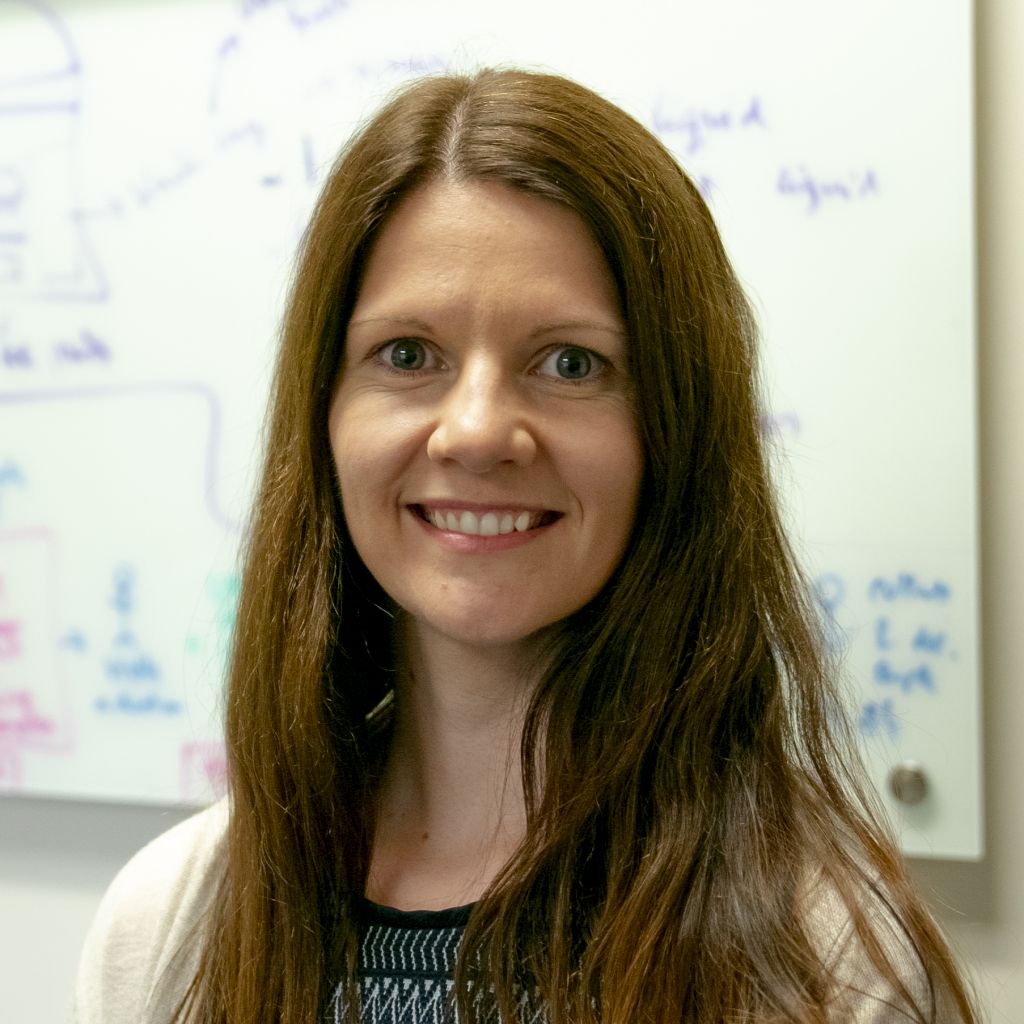
Food. It’s one of those things that connects us all. From jet-set billionaires to slum-dwelling street urchins, everyone needs to eat. Yet, in our modern, technocratic, globalized world, very few people have a direct relationship with the production of the food they need to survive. The vast majority of us buy our food from others, whether at a farm stand or supermarket shelf, which means there is almost always supply chain involved. And along that supply chain, between harvest, storage, processing, transportation, and preparation, there are lots of potential opportunities for food to pick up harmful contaminants.
That’s where Jasna Kovac is working to make a difference.
“The research in our lab is focused on food safety,” said Kovac, assistant professor of food science. “We’re primarily interested in tracing foodborne pathogens along the food supply chain and identifying critical points where they can be controlled. We’re also interested in better understanding how foodborne pathogens differ among species and within species in terms of their virulence, ability to cause disease in humans, and then also in their anti-microbial resistance.”
It’s a big issue: according to the Centers for Disease Control, there are nearly half a million hospitalizations every year due to foodborne pathogens, and more than 6,000 deaths. A 2015 paper put the conservative estimate of the economic cost at more than $55 billion.
“I like using foodborne pathogenic bacteria as a model system to study bacterial behavior because that allows me to work in a space that is closer to real-life problems and applications,” Kovac said.
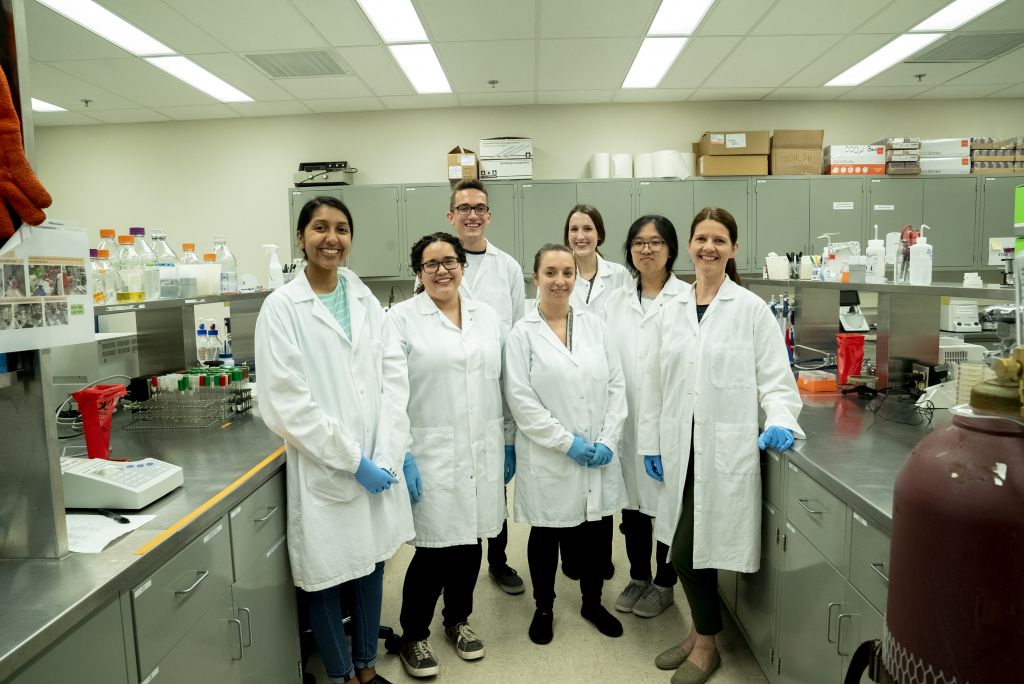
For Kovac, the interest in food came early in her studies. “My first exposure to research as an undergraduate student was in a food safety lab,” she said. “I was working on genotyping and antimicrobial resistance testing of one of the most prevalent foodborne pathogens, Campylobacter. Researching how Campylobacter develops antimicrobial resistance and how it spreads was fascinating to me. It made me ask new questions about the incredible ability of bacteria to adapt and survive in challenging environments every day.”
Her lab’s research covers a wide range of food safety approaches. They take on very specific applied work like Ph.D. student Runan Yan’s evaluation of the roasting procedures for an artisanal chocolate maker in San Francisco. They also make broader, more fundamental inquiries, such as the work of Runan and a Ph.D. student Taejung Chung, which is examining waterborne microbiomes. They aim to better understand microbial ecology in waters contaminated with foodborne pathogenic bacteria, and hopefully use microbiome signatures as sensitive indicators of unsafe water in the future.
Just improving our understanding of microbial relationships in microbiomes could help food safety investigators more quickly identify sources of pathogenic bacteria—if you can isolate specific characteristics that are more commonly found in one kind of environment, it might be possible to use that knowledge to identify sources of contamination elsewhere in the food supply chain, and focus on eliminating potential suspects before they become a health problem.
Another microbiome project, in which master's student Priscilla Sinclair is involved, is exploring interactions among microorganisms to combat the growth of Listeria in apple packing houses. In 2014, an outbreak traced to an apple processing plant in Bakersfield, California sickened dozens and resulted in seven deaths.
Regularly cleaning every inch of these often massive, busy plants can be prohibitively difficult, and missed spots can result in the establishment of biofilms where microorganisms can thrive. “Once Listeria has inhabited these biofilms, it is very hard to get rid of,” explained Sinclair.
So instead of carpet-bombing facilities with sanitizing products, she and an undergraduate student are examining subtler biological controls that can complement standard sanitation.
“We are looking at the inhibitory effects of the secondary metabolites from lactic acid bacteria,” Sinclair said. “We are applying them in the microbiome, not just in the Listeria cultures. We are taking samples from the apple packing houses and inoculating them with Listeria as well as the strains of lactic acid bacteria to see if they are able to inhibit the growth of the Listeria.”
On a similar note, Ph.D. student Laura Rolon is surveying ice cream processing facility microbiomes to identify new strains that could potentially inhibit Listeria monocytogenes.
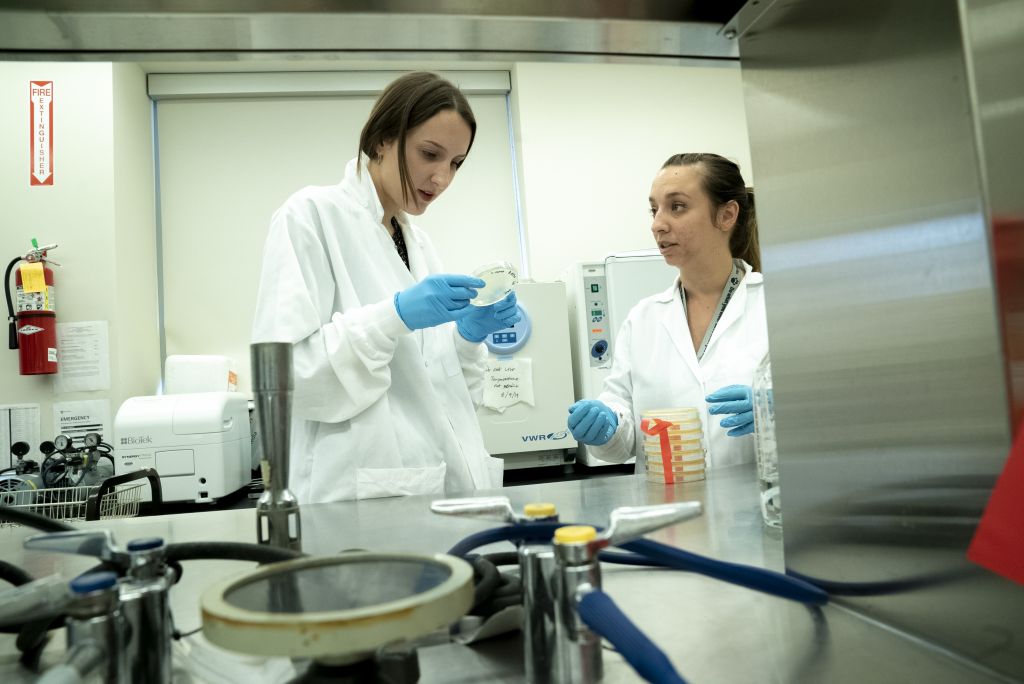
Naomi Niyah, a graduate student in the Huck Institutes’ Molecular, Cellular, and Integrative Biosciences program, deals with Bacillus cereus. Not all the closely-related species in the Bacillus cereus group are dangerous: some don’t have any effect on humans, and some are beneficial—it’s commonly used as a probiotic for animals and a bioinsecticide.
“Just because a bacterium belongs to Bacillus cereus group, that doesn’t always mean that it can cause disease in humans,” said Niyah. “We have to understand that diversity to identify features that can help us predict whether or not individual strains are likely to cause foodborne illness.”
“Different isolates come from different sources, such as from the natural environment, or isolated from food sources. I take those, grow them up, and see if they cause any cytotoxic effects on human gut cells. We try to see if there are different patterns causing cellular death and harm. This information will be combined with genomic information we have about these isolates to see the relationship between the presence of virulence genes and the effects we see in tissue culture.”
These projects are important, and they’re the bread and butter of any PI’s research portfolio—expanding our fundamental understanding of the organisms and their environments, testing potential interventions. But there’s another endeavor in the Kovac lab which is a little farther outside the box.
“One of the riskiest projects we’re tied into is with Aida Ebrahimi of Electrical Engineering,” Kovac said. “We’re developing a platform that could, in real-time and with spatial resolution, quantify bacterial interactions through conjugation.”
“Graduate student Adam Bolotsky from Ebrahimi lab is developing a microchip-based on a two-dimensional material,” explained grad student Taejung Chung. “We’re working together to quantify the conjugative interaction among bacterial cells attached to 2D materials like graphene. We hypothesize that interactions among cells will exert a shear strain on the material, which will result in changes in material’s electronic properties.”
Measuring conjugation is important, because it is one of the primary drivers of antimicrobial resistance gene transmission, and antimicrobial-resistant bacteria cause more than two million infections in the U.S. each year.
Kovac explained the somewhat serendipitous meeting which led to the collaboration with Dr. Ebrahimi.
“We were at a new faculty orientation, sitting across this huge table, and I started talking about anti-microbial resistance. Aida heard me and we moved together. We couldn’t stop talking for the rest of the day because we had so many ideas of what we wanted to do together. I really appreciated engineering input on that, and she appreciated my microbiology insight. We developed an NIH proposal, got funding, and now work together on this exciting project.”
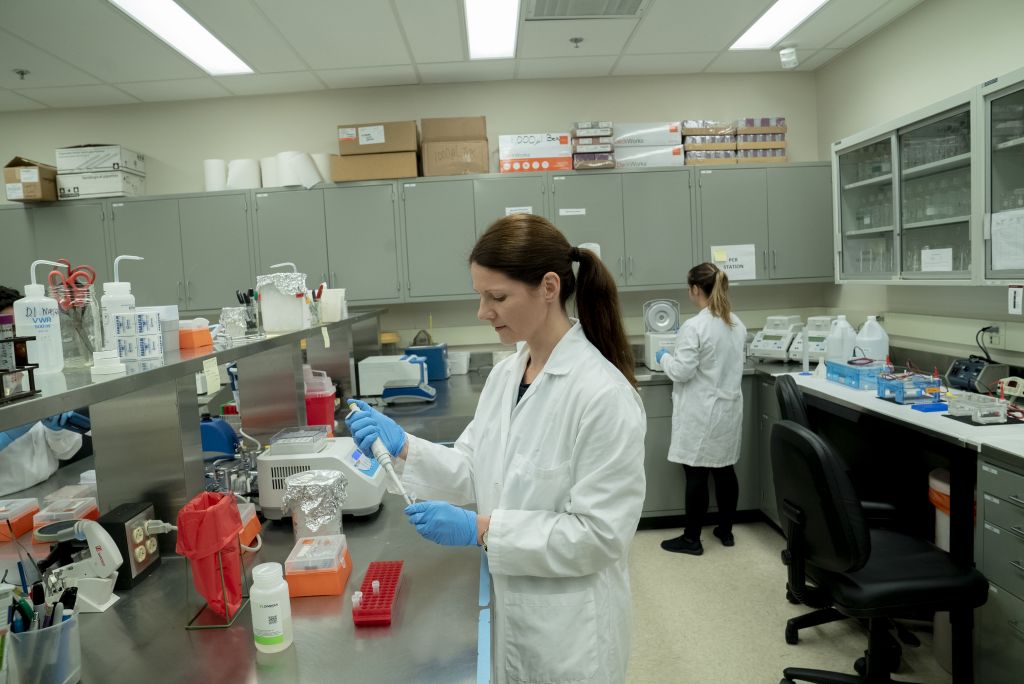
This drive for collaboration is a key part of what makes the lab tick.
“I can’t tell when I meet them if a grad student is going to be a ‘star,’” said Kovac. “But after working with students for a while, it’s really nice to see how each one of them is unique. One thing I like to do, and sometimes they are surprised about it, is to send them to another student — ‘go ask them for help,’ or ‘go help them.’ I like seeing that everyone works together, that they help each other and are a team, not just focusing on their own work.”
Kovac speaks with confidence and clarity on the science—but doesn’t come across as someone who seeks out the spotlight. Repeatedly, she takes opportunities to talk up her lab members. They, in turn, repeatedly mention her patience and her support.
“One of the most important things that you have to think of when joining a lab is definitely the culture,” said Niyah. “As grad students, this is basically your life for the next couple of years, so you have to really enjoy it. One of the things that really stuck out to me with this lab was that there’s a good relationship between undergrads, graduate students, and Dr. Kovac. We have a very welcoming and supporting environment that allows for us to work together. We all have diverse backgrounds and research experiences, so we blend those together and help each other out.”
“The only thing we ever compete for is the really nice lab coats,” she added, sparking laughter from her colleagues, who in unison, touched the ends of their sleeves. “Yeah, the ones with the really good cuffs.”
“I really don’t like competition in science,” said Kovac. “Yes, a little bit is good to move things forward, but not competition that would hinder each other’s success. I don’t like the idea of having this in the group, not even in the broader scientific community.”
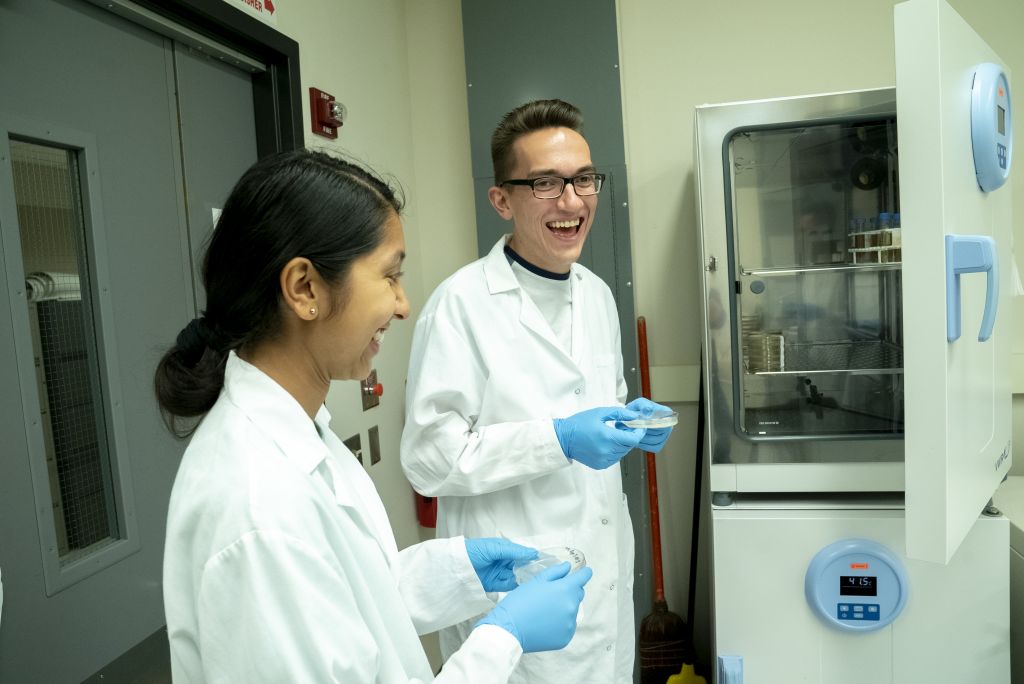
The desire for collaboration doesn’t mean that Kovac denies her students room to spread their own wings, however. She meets with them individually to make sure that their interests and goals meet with her own so that projects are designed for maximum benefit to both parties. And while she’s happy to guide, it’s vital that students can stand on their own two feet.
“My teaching philosophy is that you need to learn from your own mistakes. I encourage students to experiment, to try things out on their own. Most of them came to my lab without knowing any bioinformatics, for example—once they are here, it’s not an option for them to learn or not. We’ll provide the help and resources, but you’re going to learn. I think that makes them more confident in trying new things.”
Reflecting on what makes grad students successful, Kovac paused for a moment.
“You need to find something that’s really driving you” she answered. “Research and grad school can be challenging. They take a lot of your free time, so you need to have a good source of motivation. Obviously, you’re smart, otherwise you wouldn’t be here, but it takes more than that. It takes persistence and hard work.”